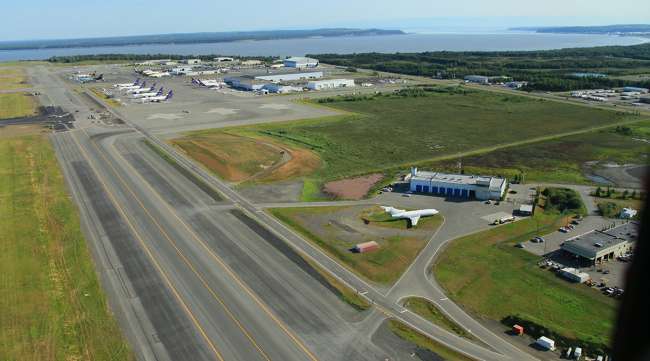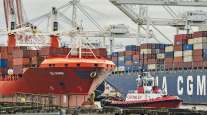Anchorage Airport Pitches New Shipping Option to Ease West Coast Snarls

[Stay on top of transportation news: Get TTNews in your inbox.]
An Anchorage, Alaska, economic development group, alongside Anchorage airport and shipping officials, is making a pitch for what they say is an unexploited maritime shipping route from Anchorage to the U.S. Northwest that could help unlock West Coast shipping snarls.
The initiative could create a long-term business opportunity for the Ted Stevens Anchorage International Airport and provide an important option for Lower 48 companies trying to move product more efficiently, they said.
Their views are based on a 29-page feasibility study conducted by Alaska-based Naniq Global Logistics, released Nov. 17.
“It’s a good relief valve in the immediate term for the challenges that the supply chain is facing, but we also see it as a long-term play for us,” airport director Jim Szczesniak said of the plan.
Companies now shipping products via ocean from Asia to Los Angeles and other clogged West Coast ports could cut their shipment time by weeks if they instead fly the items to Anchorage and load them onto ships for transport to Seattle and Tacoma, Wash., according to the study.
More than four cargo ships each week currently return to the U.S. Northwest coast empty, after they have dropped off at the Port of Alaska their load of groceries, cars and other goods Alaskans need.
The proposed option would be 23% cheaper than flying products directly from Asian cities to the Lower 48, the study says.
And freight could be moved to West Coast distribution centers in as little as six or seven days when plane and ship schedules align in Anchorage, according to the $100,000 study, which was released by the airport and Anchorage Economic Development Corp.
That schedule would cut weeks from the time it takes to ship products over the ocean to their U.S. destination, the study says.
The West Coast delays have added from 30 to more than 75 days to shipping schedules, AEDC President Bill Popp said.
The Anchorage airport already is one of the top airports in the world for cargo shipments. But air freighters, laden with computers, clothing and other items, typically pass through on their journey from Asia to the Lower 48. They refuel, take on rested pilots, and go.
The initiative, called the Anchorage Pacific Air-to-Sea Service, could boost the amount of cargo moving through the airport. The cargo would be offloaded at the airport, then hauled by truck to waiting ships in the port in Anchorage.
Such ideas have been pursued in Alaska in the past, officials at the press event said. But this time is different.
Americans who piled up savings amid the COVID-19 lockdowns have boosted their demand for items from Asia. That has contributed to inflation, and the shipping delays that could last well into next year or longer.
“This is distinctly different because our view is this is sort of a moment in time,” said Dave Karp, senior vice president for Alaska for Saltchuk, which owns shipping and logistics companies. “We’ve seen some very drastic changes in the global supply chain. A lot of the conversations we’re having with our customers is about time, and time is money.”
Darren Prokop, a professor of logistics and supply chain management at the University of Alaska-Anchorage, said the plan is a short-term opportunity. It could help shippers who need to work around the current supply glitches and move items relatively quickly to the Lower 48.
“It’s a chance to move things on an expedited basis for those shippers that can’t wait an extra week to a month to get stuff where it needs to be,” he said.
But it may not be sustainable beyond the West Coast shipping snafus, he said. Long term, it could have difficulty competing against marine shipments from Asia to the West Coast because of the relatively low cost of that route, he said.
Officials at the meeting said they believe the idea could survive after the current shipping disruptions end.
Companies interviewed for the study, which included Walmart and FedEx Ground, indicated they already would have been using the new shipping option if it had been available, the study says.
They said they also would consider using the option after West Coast shipping issues end, according to the study.
Popp said the next step will be marketing the study’s findings to retailers, manufacturers and shipping companies to help win customers for the plan.
“We believe strongly the research has demonstrated there is a case to be made,” Popp said, “and now it’s a matter of making it available to all the parts and pieces and players that are going to be important to making this successful.”
Want more news? Listen to today's daily briefing below or go here for more info:
Distributed by Tribune Content Agency, LLC




